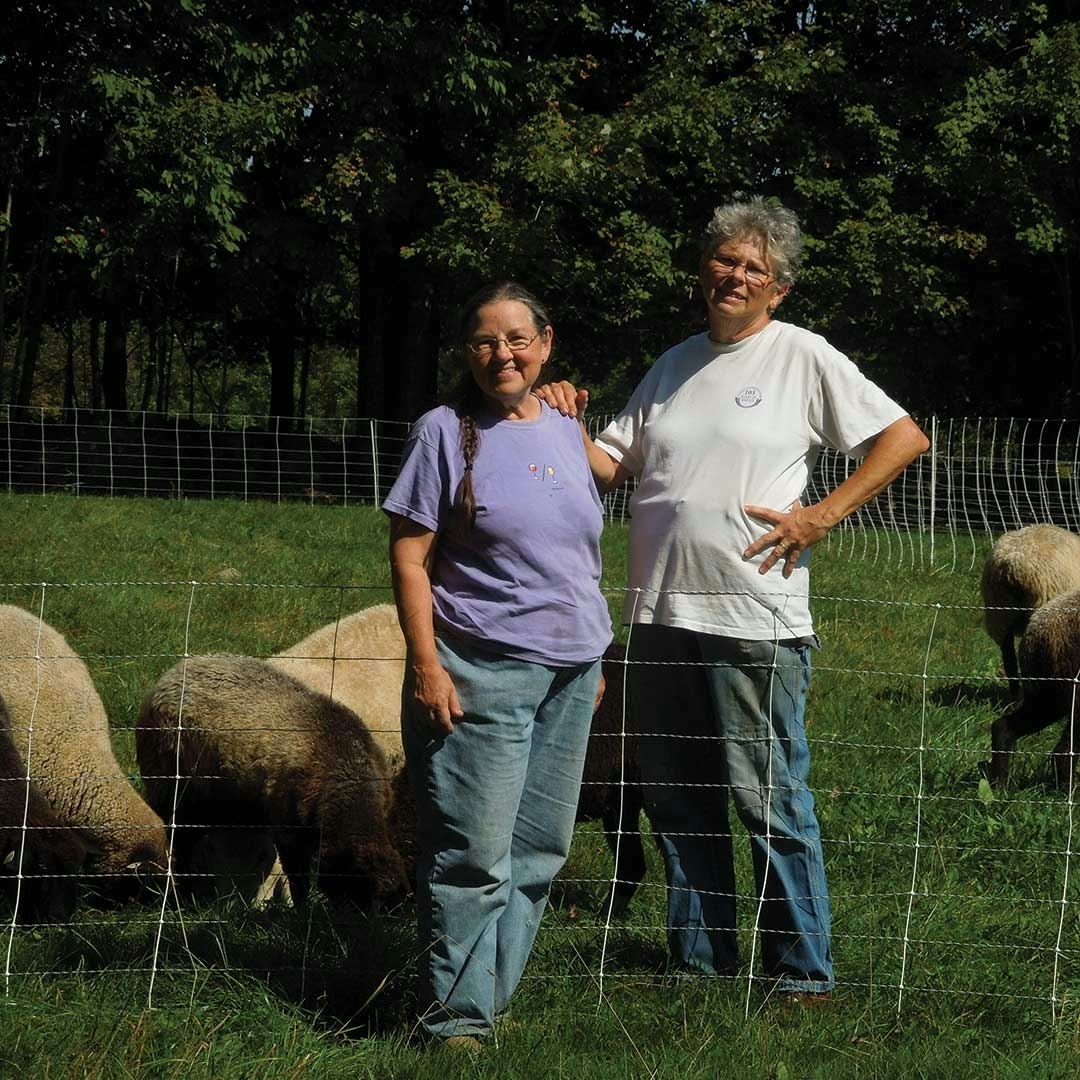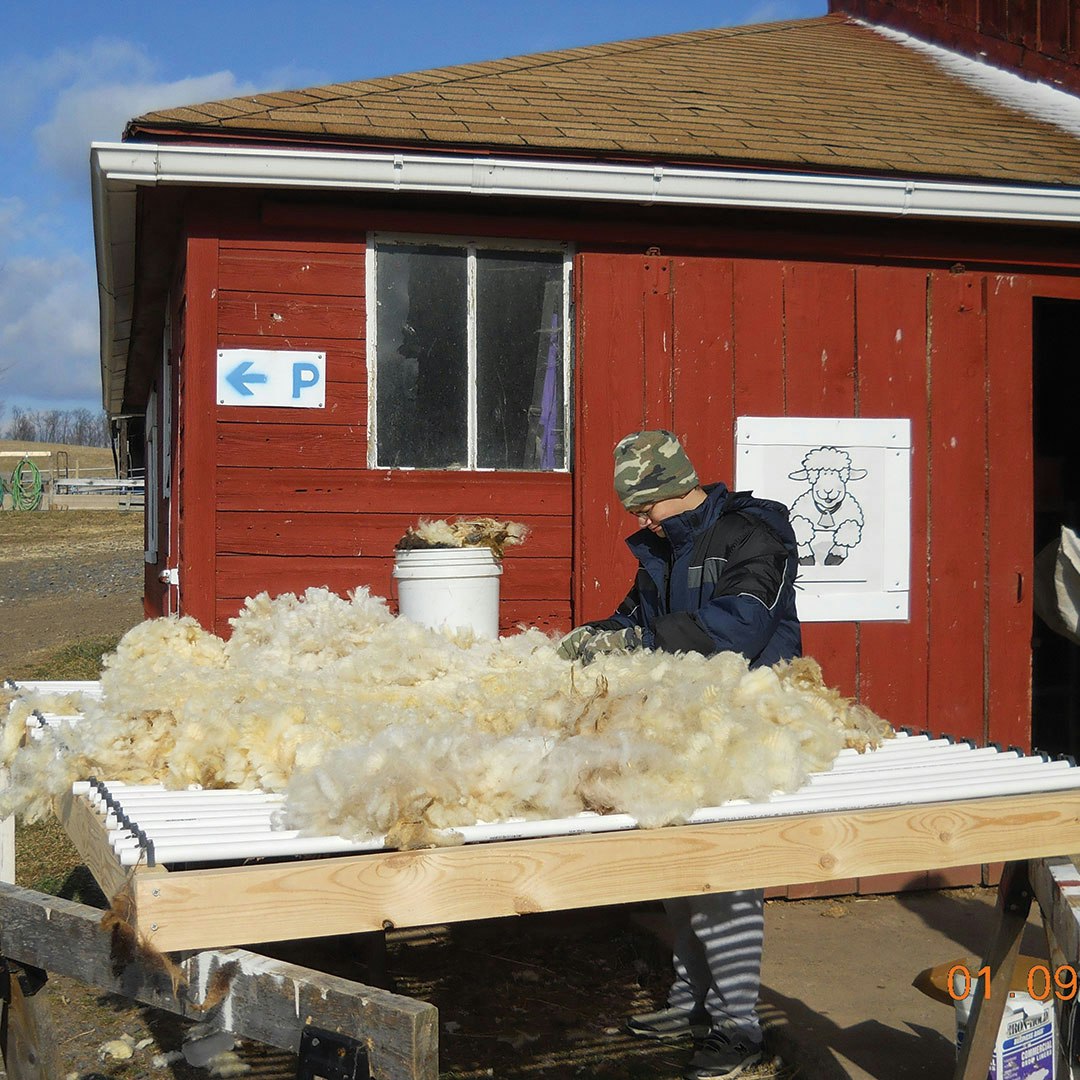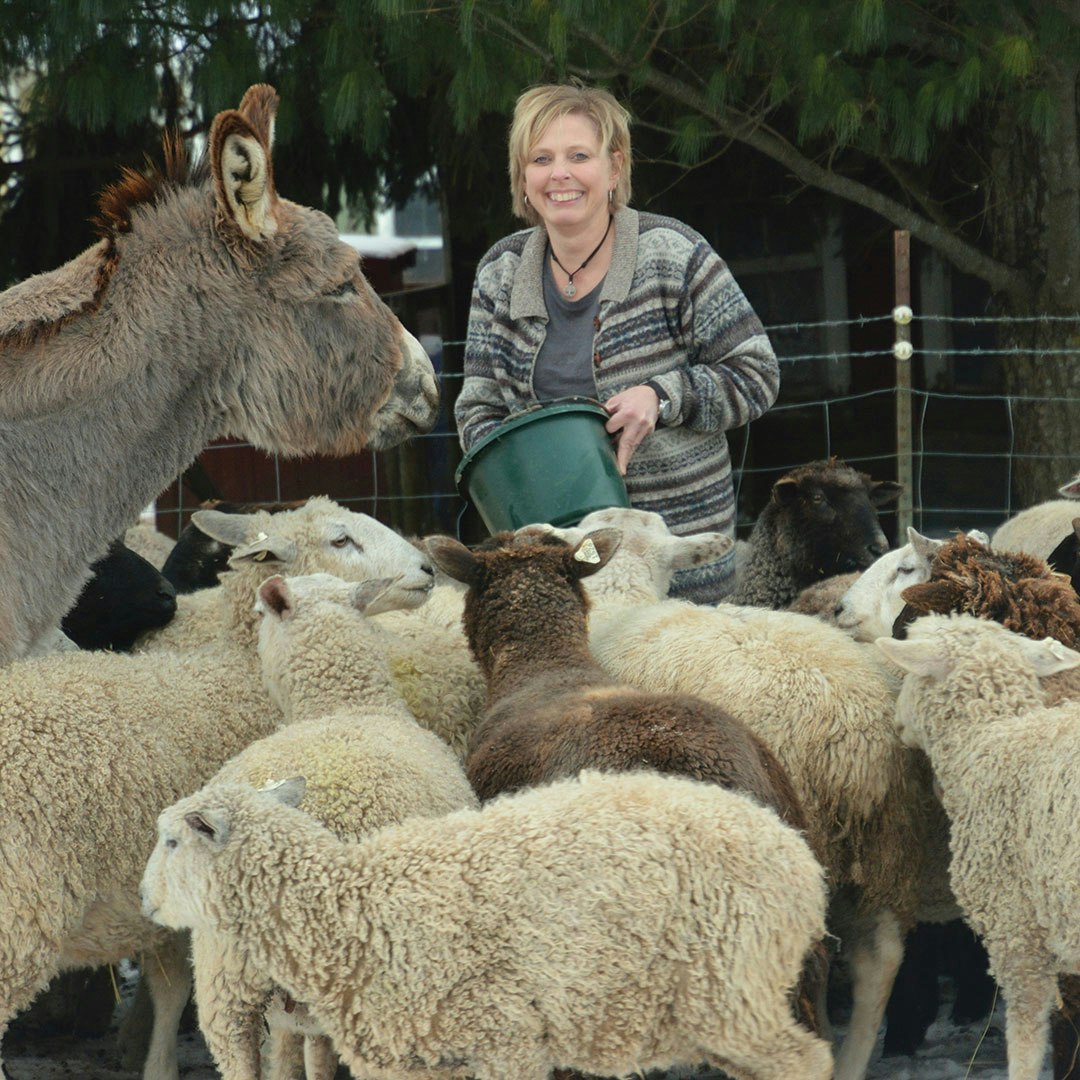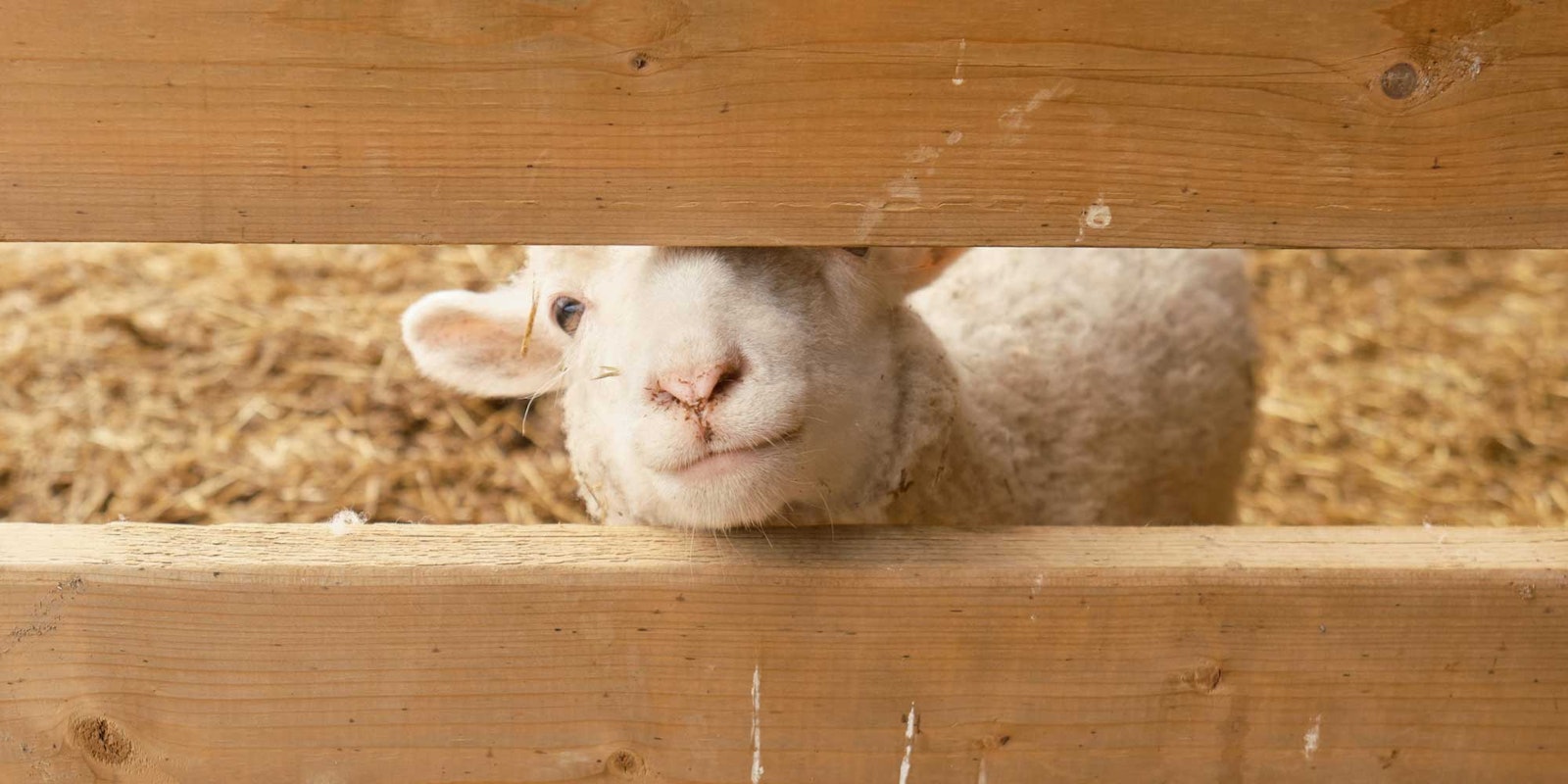This Valentine’s Day (or any day) say you love someone with sheep’s wool! (Wool is the traditional gift for the 7th anniversary.) In the Fall 2018 issue of Spin Off, I asked three farms—A Wrinkle In Thyme Farm of Sumner, Maine; Owens Farm of Sunbury, Pennsylvania; and Windridge Fiber Farm of Hollandale, Wisconsin—to share something about their adopt-a-sheep programs.

Martha Elkin and Mary Ann Haxton of A Wrinkle In Thyme Farm. Photo courtesy of Martha Elkin
Spin Off (SO): Why did you decide to start an adopt-a-sheep program? What has that experience been like for you?
A Wrinkle In Thyme Farm (AWTF): We wanted to find a way to bring people out to our farm to see what we have to offer. A knitter friend of ours suggested the idea of offering our sheep for adoption. We enjoy the appreciation and affirmation from people who adopt a lamb. They develop a new awareness of all that is involved in raising sheep and processing wool.
Owens Farm (OF): Our program dates back to before the internet [was popular]. We began raising sheep and offering educational programs on our farm in the early 1990s. This evolved into “Sheep in a Box,” where customers received a fleece plus assorted educational materials about sheep and wool. Remember, those were the days when gathering knowledge meant writing away for brochures, seeking photocopies of interesting tidbits and newspaper clippings, and going to the library for reference material. There was tremendous value in purchasing physical kits in which the material and information had already been gathered. This concept became obsolete as the internet took off, but the digital age still can’t replace an authentic experience, and our yearlong sheep adoption program was born.
Windridge Fiber Farm (WFF): We started our adopt-a-sheep program in 2007. We were searching for a way to help our customers connect with our farm in a more personal way, and an adopt-a-sheep program seemed to be a perfect answer. Adopters gain insight into the day-to-day operation of our farm as well as get a closer look at where the wool comes from through our newsletters. Making friends all over the United States and keeping in touch with some of our first adopters continues to be an unexpected pleasure from the program. Adopters visit our farm, and we always enjoy showing them the sheep and where they live.

Tim Schnee skirting a Coopworth fleece at Owens Farm before taking it home. Photo by Caroline Owens
SO: How has your adopt-a-sheep program evolved since it began?
AWTF: The program has not changed much, except to grow. Some of the participants don’t actually see their lambs through the summer. However, there is a lot of interest from adopters on their lambs’ first shearing day, which is in the fall.
OF: The idea for one of our most popular programs came from our adopt-a-sheep community. Wanting to share in the preparation and excitement of lambing season, many wished they could be present, and the Lambing-Time Slumber Party was born. Small groups of adopters get to spend the night during the thick of lambing. The geographical scope of our adoption program has expanded, too. We have had adoptive families from 25 states so far. Some maintain “pen pal” status, and others have visited the farm in person. We have a guesthouse for overnight stays at the farm, which makes it easier for remote adopters to visit their sheep.
WFF: In the beginning, we only had adult sheep available for adoption. We have found that people enjoy the anticipation of the lambs arriving and the bonus of naming a lamb, so now we offer lambs for adoption, too. The change began when the ewe someone wanted to adopt was already taken, so we offered her lamb as an alternate option. Some adopters select a lamb when it is born and continue to adopt the same ewe as she gets older, year after year.

Clementine the donkey and the sheep all come running when Windridge Fiber Farm owner Tami Bowser has a bucket of food in her hands. Photo by Brooke Bowser
SO: What is a memorable or especially challenging aspect of hosting an adopt-a-sheep program?
AWTF: It’s challenging when we lose contact with a person who has adopted a lamb and have to figure out how to get in touch with them during shearing time. Fortunately, we’ve always found them.
OF: I am still astonished by the creativity our adopters express. I didn’t know there would be so many couples commemorating their seventh anniversaries with the traditional gift of wool, or that for other couples, the sheep adoption would be the first concrete step toward their shared dream of country life. Countless Welcome Kits (the first step in the adoption) have been mailed to offices or alternate addresses to maintain secrecy until a birthday, anniversary, or Christmas. Personally, my biggest challenge as a shepherd is to predict way in advance when a sheep should no longer be adopted because of age or health status.
WFF: One sweet memory comes from an adopter sending a package of chocolate chip cookies during lambing time. She thought I needed some extra energy, and she was right. It sure put a smile on my face when I opened the package! I was amazed she had been so touched by what was happening here to reach out with such a kind act. Another time, I received emails of support in response to a newsletter sharing the loss of a dear, old ewe. The people that I have met through the years, even if only by email, have truly become friends.
SO: What should a handspinner think about before selecting a sheep to adopt?
AWTF: Some spinners may want to know the breed. Color is another factor, which sometimes changes as the lambs grow. Softness, length, and crimp of the fiber are other things to consider. Lambs may get the characteristics of either or both parents. But sometimes it is friendliness of the lamb that attracts a spinner.
OF: Our very first step upon receiving a new adoption registration is to query the adopter about her plans for the wool and color preference. We factor in that information and choose a sheep based on availability, fleece quality, jacket habits (some are Houdinis at getting their fleece-protecting jackets off !), age, health, and performance status.
WFF: I usually begin with the color of fleece they would like. We have both white and natural-color sheep to choose from. Next, I like to find out what type of projects they like to do or their plans for the wool. This helps me know if a Cotswold with its strong, lustrous wool would be a good match, or if maybe a Bluefaced Leicester lamb with a softer fleece would be better. Some customers are new to spinning and not sure what type of wool they want. In this case, I try to pair the adopter to a sheep with easy-to-spin fleece.
For more information on adopting a sheep from one of these farms:
A Wrinkle In Thyme Farm, www.awrinkleinthymefarm.com
Owens Farm, www.owensfarm.com
Windridge Fiber Farm, www.windridgefiberfarm.com.
For the urban handspinner who dreams of a flock of her own, the experience of adopting a sheep is a great alternative to abandoning city life and moving to the country!
Elizabeth Prose is a former associate editor of Spin Off.
Originally published February 7, 2019; updated February 14, 2022.

